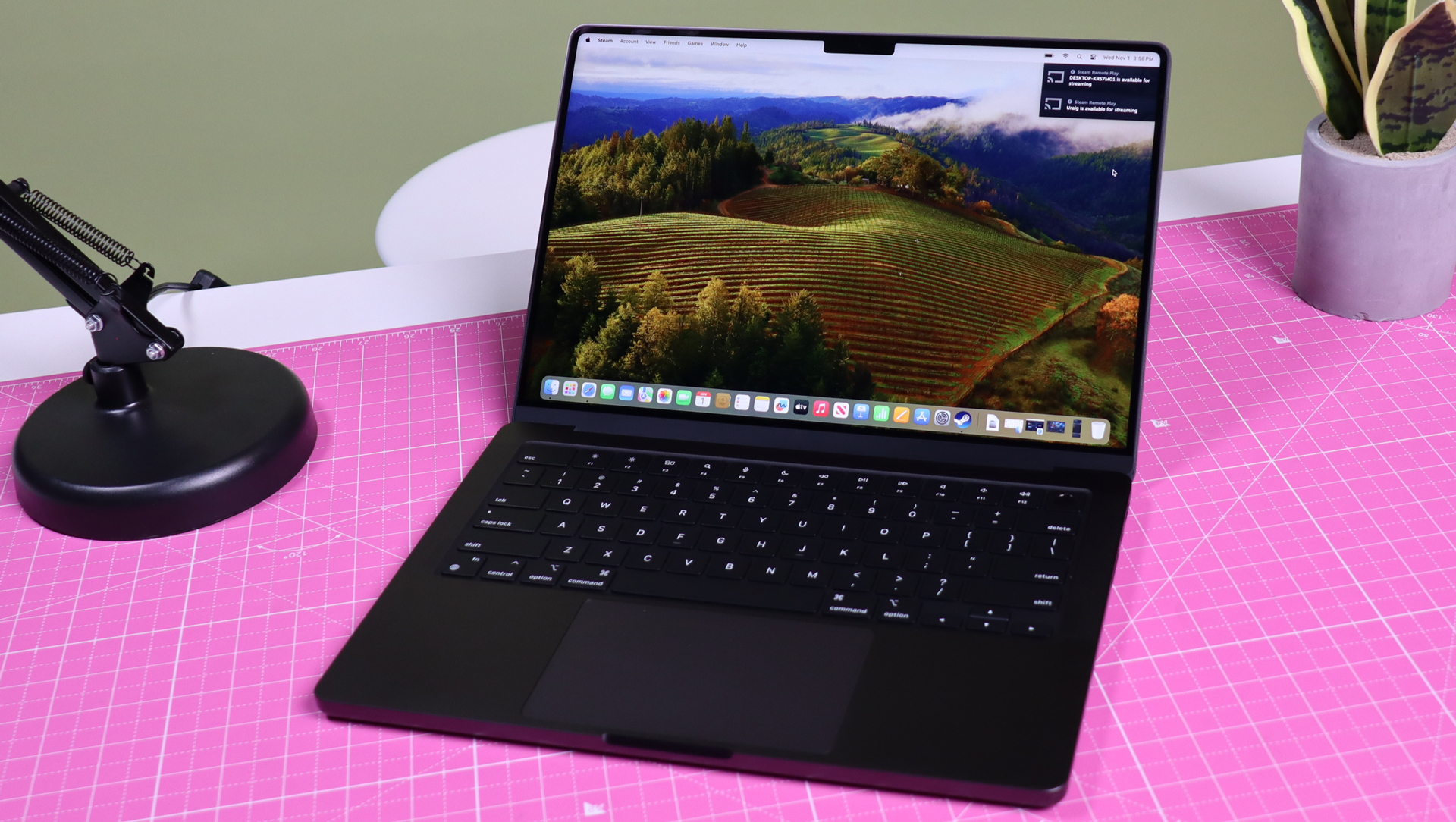
Two-minute review
Here is the MacBook Pro (M3 Max, 2023) configuration sent to TechRadar for review:
CPU: Apple M3 Max (16-core)
Graphics: Integrated 40-core GPU
RAM: 64GB [Unified LPDDR5]
Screen: 14.2-inch, 3024 x 1964 Liquid Retina XDR display 600 nits (1,600 peak nits with HDR content) brightness, wide color P3 gamut
Storage: 2TB SSD
Ports: 3x Thunderbolt 4 (USB-C), 3.5mm headphone jack, MagSafe 3 charging port, SDXC, HDMI
Connectivity: Wi-Fi 6e, Bluetooth 5.3
Camera: 1080p FaceTime HD webcam
Weight: 3.6 pounds / 1.24kg
Size: 12.31 x 8.71 x 0.61 inches / 31.26 x 22.12 x 1.55cm; W x D x H)
The story of the new MacBook Pro 14 is less about a new laptop on the block than it is about Apple showcasing the raw power of Apple's newest silicon, the M3 chip. Stuffed inside my brooding Space Black portable is Apple's apex M3 processor, the M3 Max. I tell you this so that you don't mistakenly expect that your $1,599 / £1,699 / AU$2,699 MacBook Pro 14 with an M3 chip will provide the same performance as what's cooking on my $4,299 / £4,399 / AU$7,249 review unit.
The base-model M3 will still support hardware-based ray tracing and mesh shading. It'll still have that blazing-fast neural network. But you'll have many fewer CPU and GPU cores, and much less memory; the M3 Max model has 64GB. You're buying a casually powerful Pro system. The M3 Max MacBook Pro came to play hard and work hard (it's tough to say which it'll go at harder).

From the impressive design and materials (aluminum chassis with a brand-new anodizing technique for the Space Black finish that finally cuts down on fingerprints) to the expressive keyboard that is now my favorite MacBook typing experience, to a versatile macOS Sonoma platform that supports every activity from entertainment and gaming to email, web browsing, and intense photo and video work, there is not one hint of performance disappointment in this system.
It's without a doubt the best MacBook I've ever used, and I think it stands a chance of giving some of the best gaming laptops a real run for their money.
This is not, by any stretch of the imagination, an affordable laptop, and if you're looking for thin, light, relatively budget-friendly, and are not working on massive CAD files, 4K video streams, or playing the latest AAA games, then perhaps the still-stellar MacBook Air M2 (no M3 yet) is more your style, or even the MacBook Pro 14 with M3. As mentioned, that model starts at $1,599 / £1,699 / AU$2,699 – that's $100 cheaper than the 14-inch MacBook Pro with M2 in the US, but is also a reminder that there's no $1,299 tier in MacBook Pro space.
There's little doubt in my mind that the complete lineup of MacBook Pro 14 M3 machines, from the base M3 to the M3 Pro and this M3 Max, will take their places among the best laptops money can buy. And, yes, the MacBook Pro 14 M3 Max could also snare a spot on our best gaming laptops list.
MacBook Pro 14-inch (M3 Max, 2023) review: Price and availability
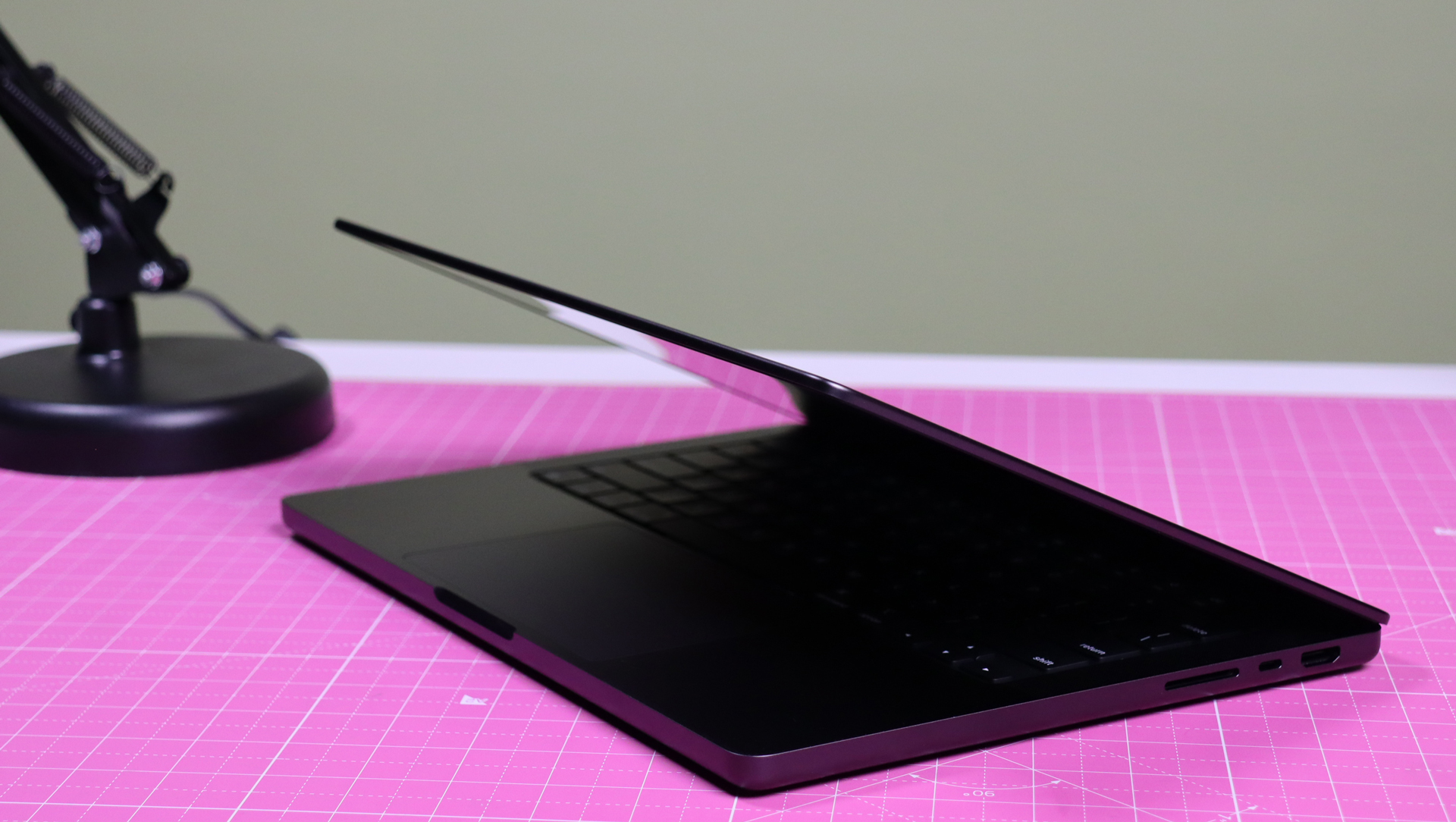
- M3 range starts at $1,599 / £1,699 / AU$2,699
- Tested model costs $4,299 / £4,399 / AU$7,249
- No 13-inch option (which would have cost less)
Apple announced the new MacBook Pro 14-inch range at its October 30 Scary Fast event, alongside new 16-inch MacBook Pros. The 14-inch MacBook Pro now comes with a choice of M3, M3 Pro, and M3 Max chips, the latest generation of Apple's own silicon. Meanwhile, the 16-inch MacBook Pro is only available with the higher-end (and more expensive) M3 Pro and M3 Max. There's also a new iMac 24 running on the base M3 SoC.
Preorders are live now, and the new M3 and M3 Pro MacBooks will go on sale and ship from November 7, while the M3 Max models will begin shipping later in November.
The MacBook Pro 14-inch M3 range starts at $1,599 / £1,699 / AU$2,699 (it's worth noting that Apple has discontinued the 13-inch MacBook Pro). As configured, our Space Black MacBook Pro 14-inch with an M3 Max SoC, 64GB of RAM and a 2TB hard drive has a list price of $4,299 / £4,399 / AU$7,249.
- Price score: 4/5
MacBook Pro 14-inch (M3 Max, 2023) review: Design
- Same design
- More power squeezed into the same space and weight
- An awesome new color option
Apple has changed virtually nothing about the MacBook Pro design from the 14-inch model it launched earlier this year with an M2 chip. The dimensions are the same, with a thickness of 0.61 inches / 1.55cm, a width of 12.31 inches / 31.26cm, and a depth of 8.71 inches / 22.12cm.
The weight is roughly the same, though the M3 Max 14-inch MacBook Pro is, at 3.6lbs / 1.24kg, the heaviest of the 14-inch bunch.
The screen size is the same, and on the M3 Max and M3 Pro 14-inch MacBooks the port placement is unchanged from the previous generation, as are the number and types of ports. You get three USB-C Thunderbolt 4 ports, a 3.5mm headphone jack, an HDMI port, an SD card slot, and a MagSafe charge port (if you opt for the base M3 model you only get two Thunderbolt ports)
If you stack the MacBook Air 13-inch M2 on top of the MacBook Pro 14-inch M3 Max, the latter doesn't look that much larger, but it is substantially thicker and heavier. When I opened it up to reveal that familiar Liquid Retina XDR display and backlit Magic Keyboard, I noted that the keyboard and trackpad are, from a size perspective, exactly the same as on the MacBook Air. Apple uses the extra chassis space on the Pro to accommodate a six-speaker system that's split to sit on either side of the keyboard; the larger chassis also provides just a bit more space to rest your palms.


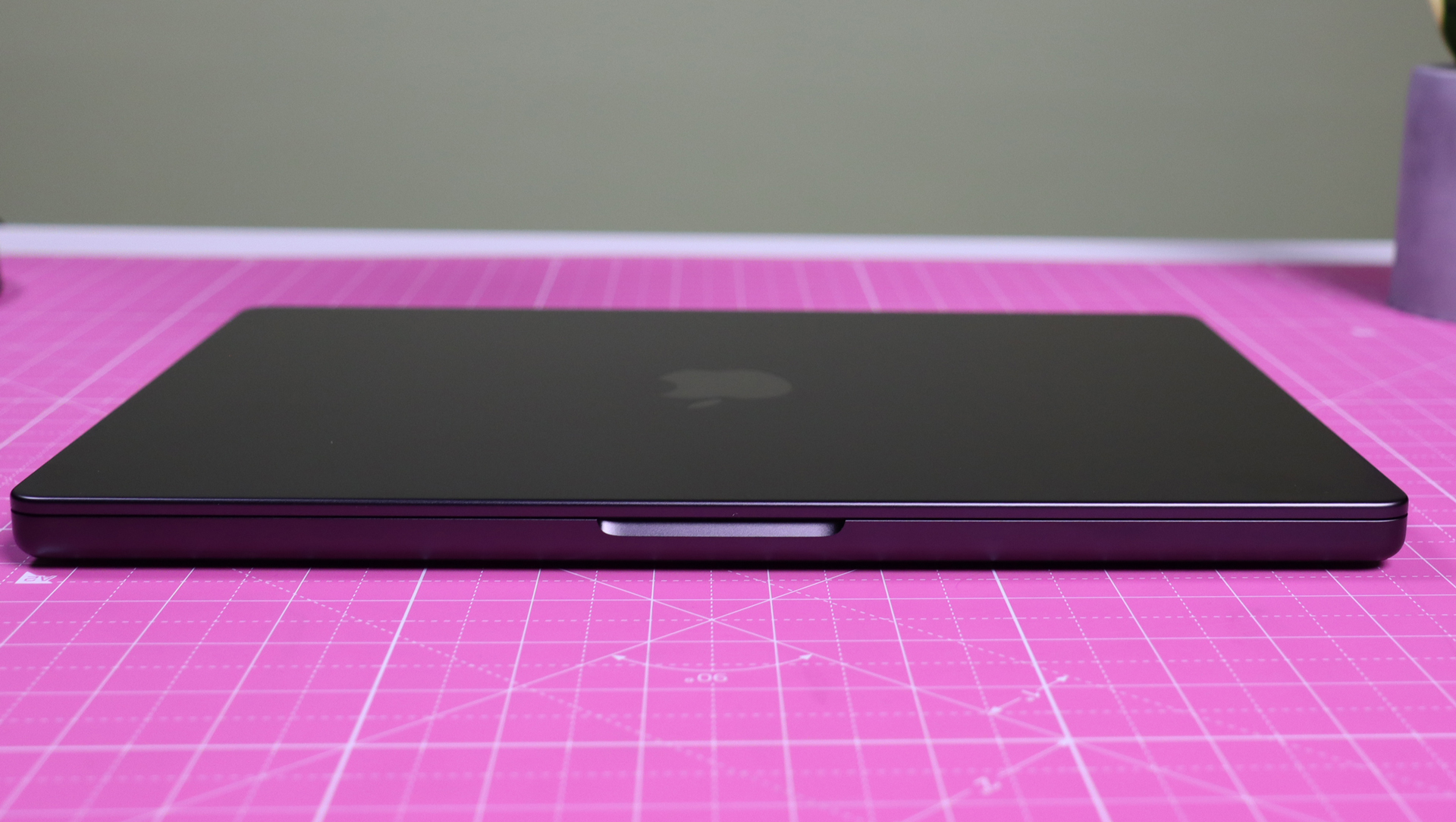
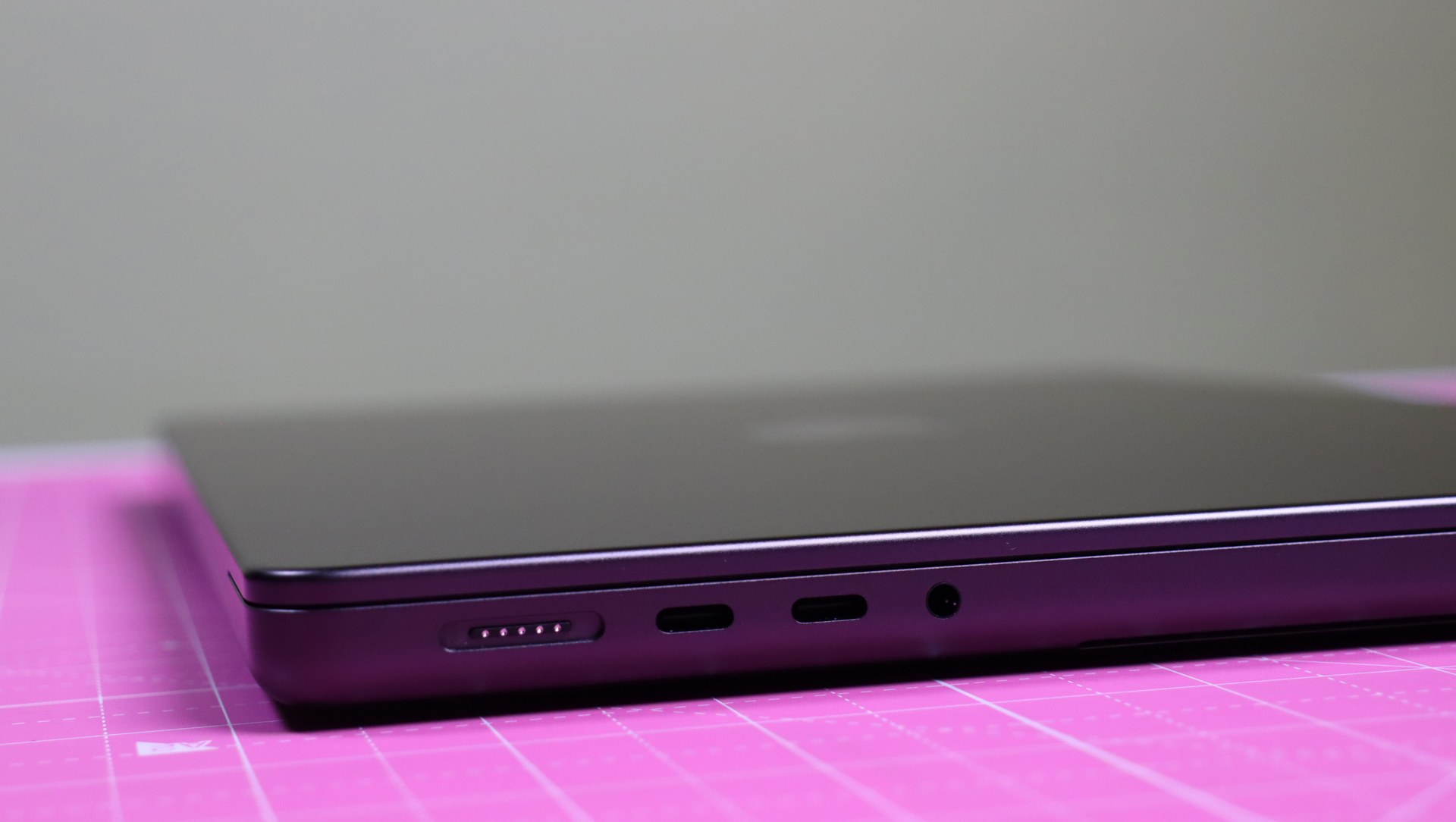

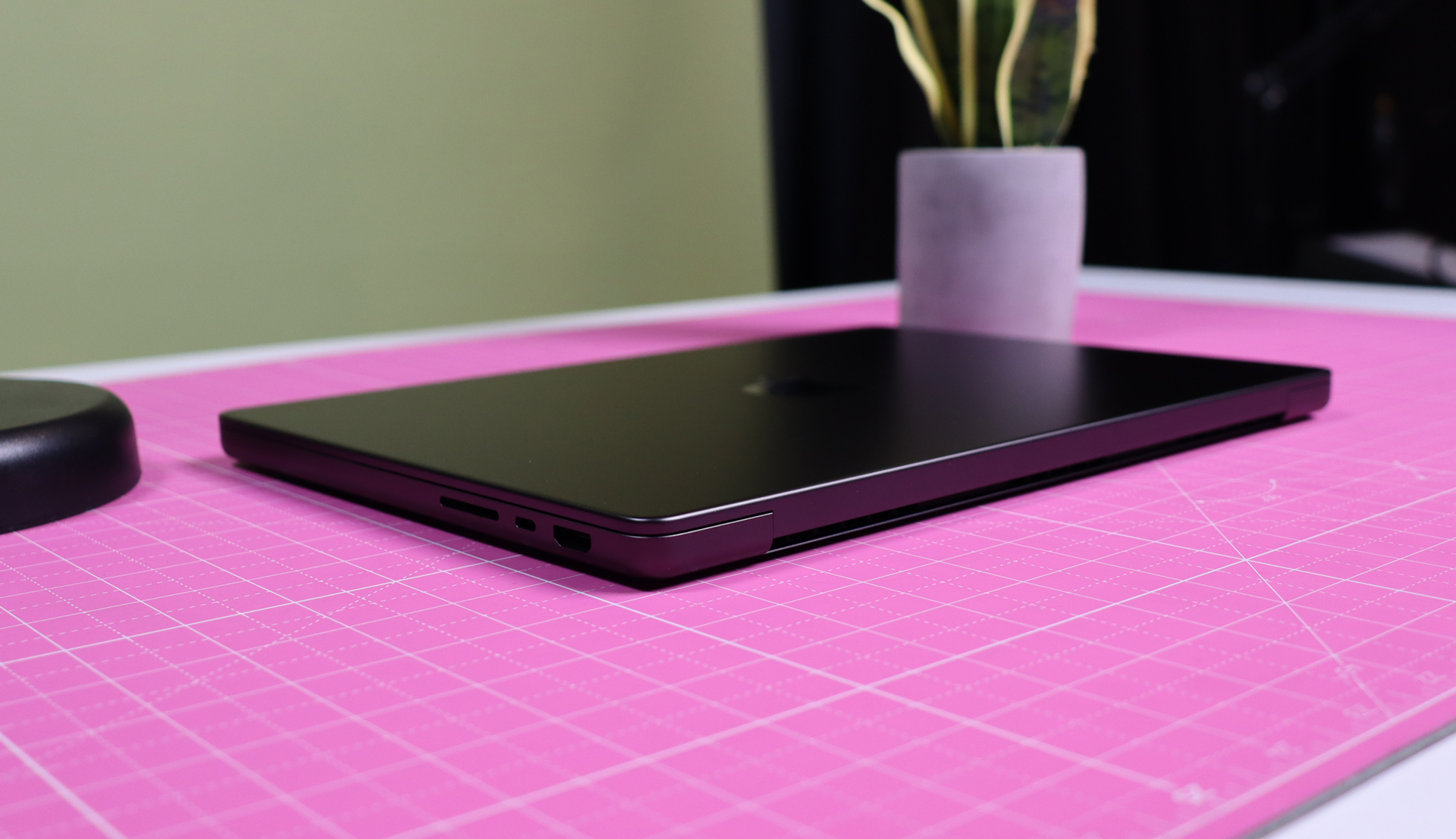
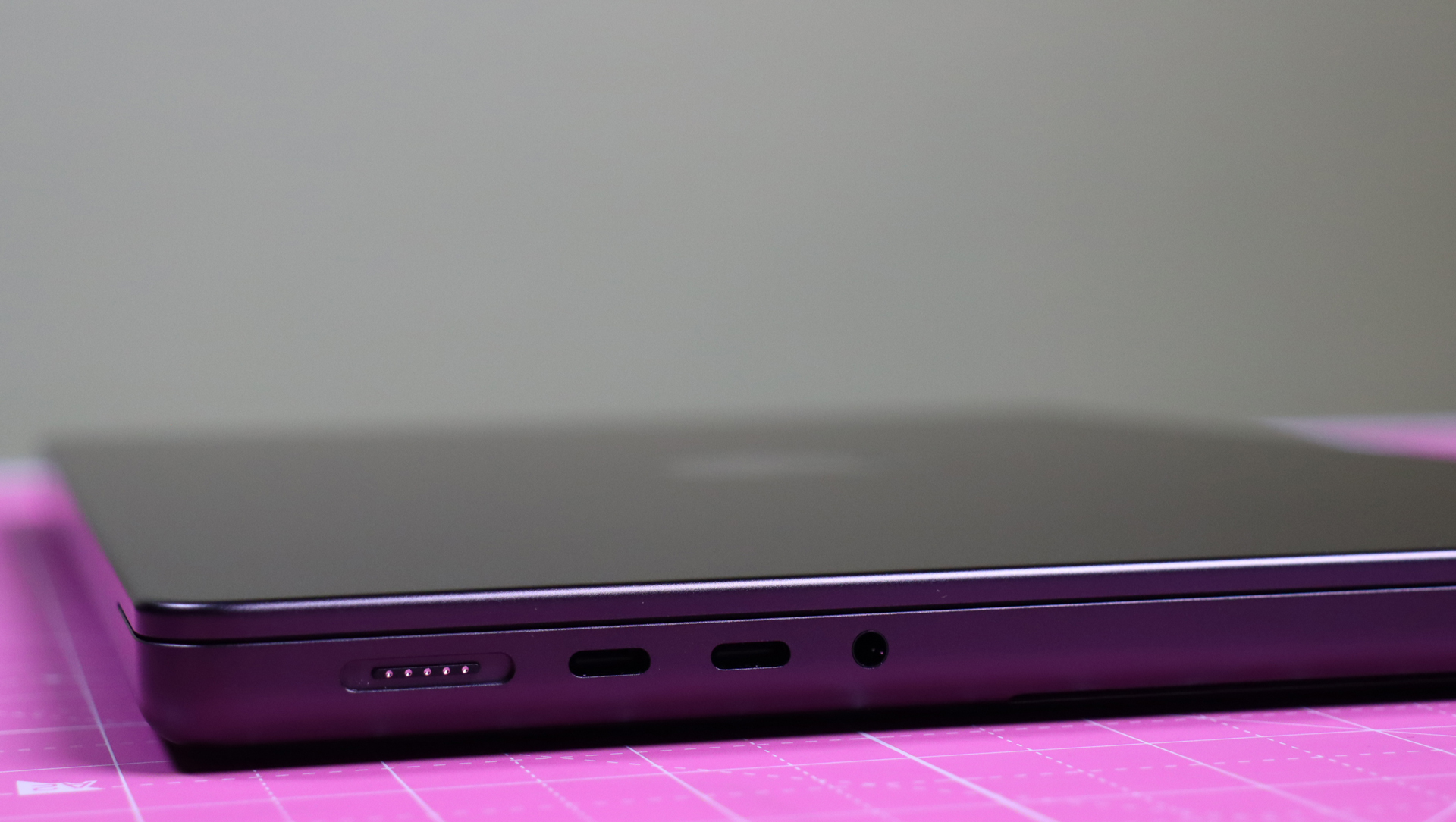
As with the previous 14-inch MacBook Pro, the matte keyboard feels as good as it looks. It's expansive, and there's enough key travel to make every touch sure and satisfying; it's a pleasure to type on. The power button still doubles as a Touch ID biometric scanner, which I use to unlock the laptop and sign into various online services. I still hope for the day that Apple introduces Face ID to the FaceTime camera notch that sits at the top of the display.
But enough about everything that's the same. I want to talk about the new Space Black finish. Sure, Apple has done colorful and even inspired finishes before, but I'd argue there's never been anything quite like the new Space Black finish on this new MacBook Pro 14 M3 Max (the 14-inch M3 Pro and M3 Max MacBooks are available in Space Black or silver, while the M3 model comes in Space Grey or silver).
It's not just black – it's a light-swallowing black. I noticed this when trying to photograph the new laptop, and watched as it basically devoured my studio lighting. The surface is just shy of being matte black, and that low reflectivity really stops the light from bouncing back at you. The new color gives the laptop a bold, aggressive, and no-nonsense look. I think any gamer would be proud to cart this laptop into their next tournament.
Apple has developed a new anodizing process for the Space Black color to create a fingerprint-resistant surface, and I can report that it did repel most of my handprints. That said, I have dry hands, and I did note that the sweatier the palm, the more visible the marks left on the laptop's surface, although even those fingerprints were faint. Just remember that this is a fingerprint-resistant MacBook Pro, not a fingerprint-proof one.
- Design score: 5/5
MacBook Pro 14-inch (M3 Max, 2023) review: Display
- Same resolution
- Still excellent
- It's brighter! (With standard imagery)
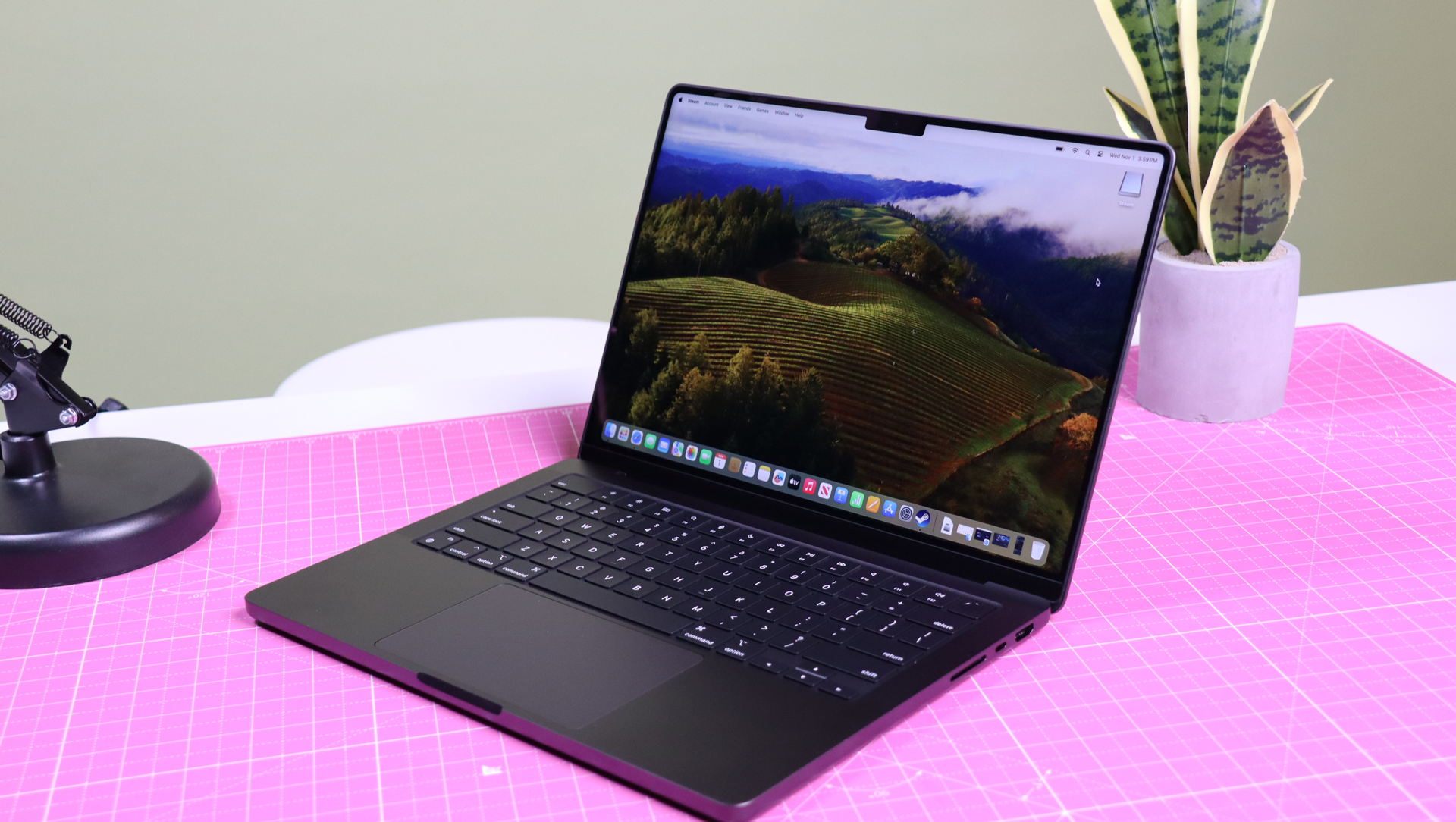
In typical fashion, Apple has managed to not change anything about its MacBook Pro Liquid Retina XDR display, but has still managed to squeeze some extra performance out of it thanks to the new and more efficient 3-nanometer M3 Max chip.
The screen has the exact same resolution as the last display panel (3024 x 1964), and the same one million-to-1 contrast ratio. Even the same peak brightness of 1,600 nits with HDR content is unchanged, although for day-to-day brightness with standard content we now get 600 nits, as opposed to the 500 nits on the last MacBook Pro.

In real-world use, I found that the MacBook Pro 14-inch with M3 Max is quite capable of beating back even direct sunlight; I'm convinced I could work pretty much anywhere on this laptop.
Overall, this is a beautiful screen. Thanks to bright colors and inky blacks, everything on it gets a premium look. Do I mind the FaceTime camera notch? Not really. Video usually plays in letterbox format and well below it, and it doesn't interfere with the business part of apps and web browsing. Even when I played games – and I played a lot of them – I didn't notice it.
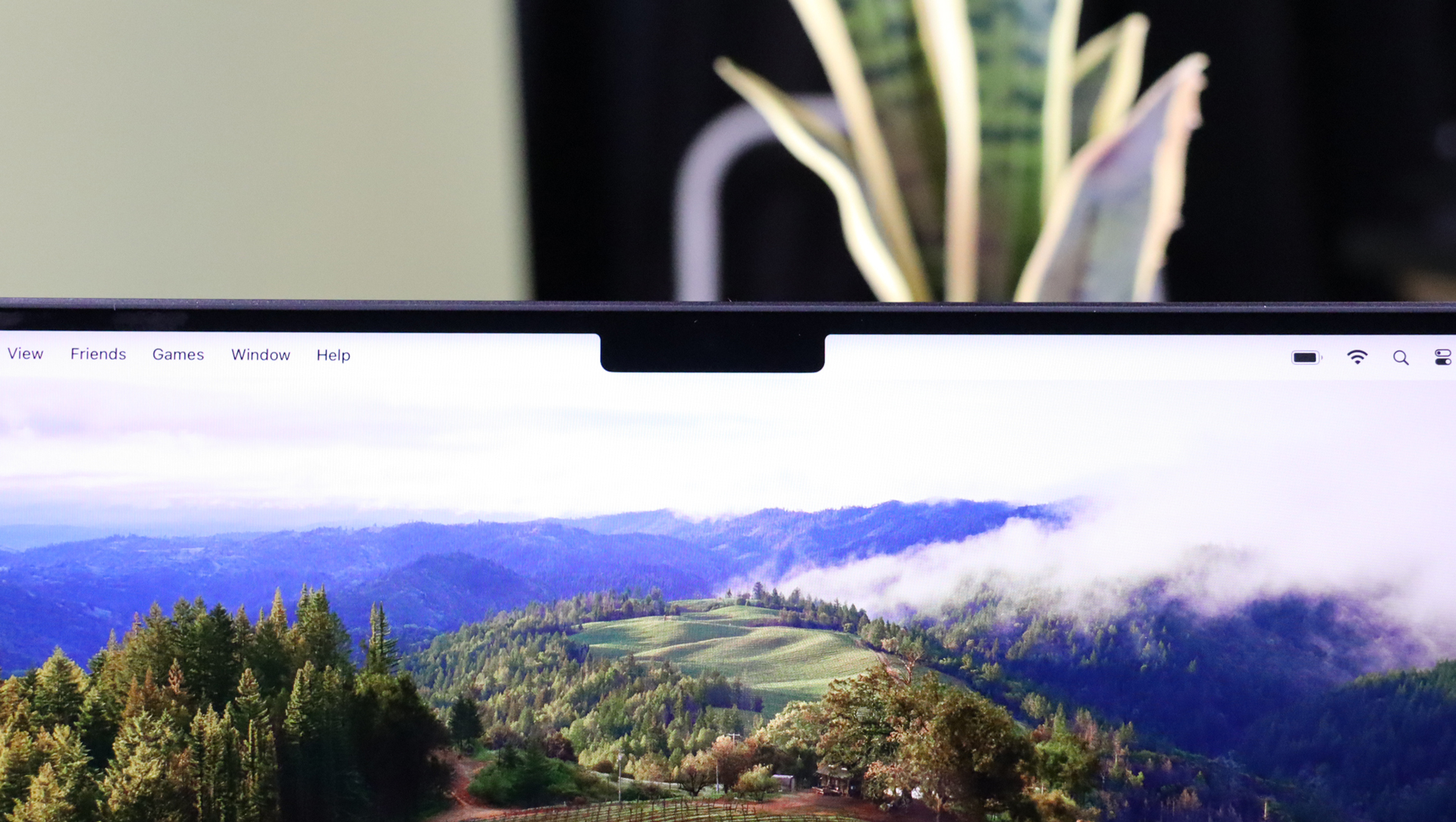
- Display score: 4.5/5
MacBook Pro 14-inch (M3 Max, 2023) review: Performance
- Apple silicon at its finest
- Good luck finding a task it can't handle
- AAA gaming can chew through battery life
Here’s how the MacBook Pro (M3 Max, 2023) performed in our suite of benchmark tests:
Cinebench R24CPU: Single-core: 140; Multi-core: 1,588, GPU: 12791; MP Ratio: 10.94
Geekbench 6 Single-core: 3,160; Multi-core: 21,236; GPU Metal: 158,215; OpenCL: 92,159
Battery life: 10 to 12 hours with mixed use
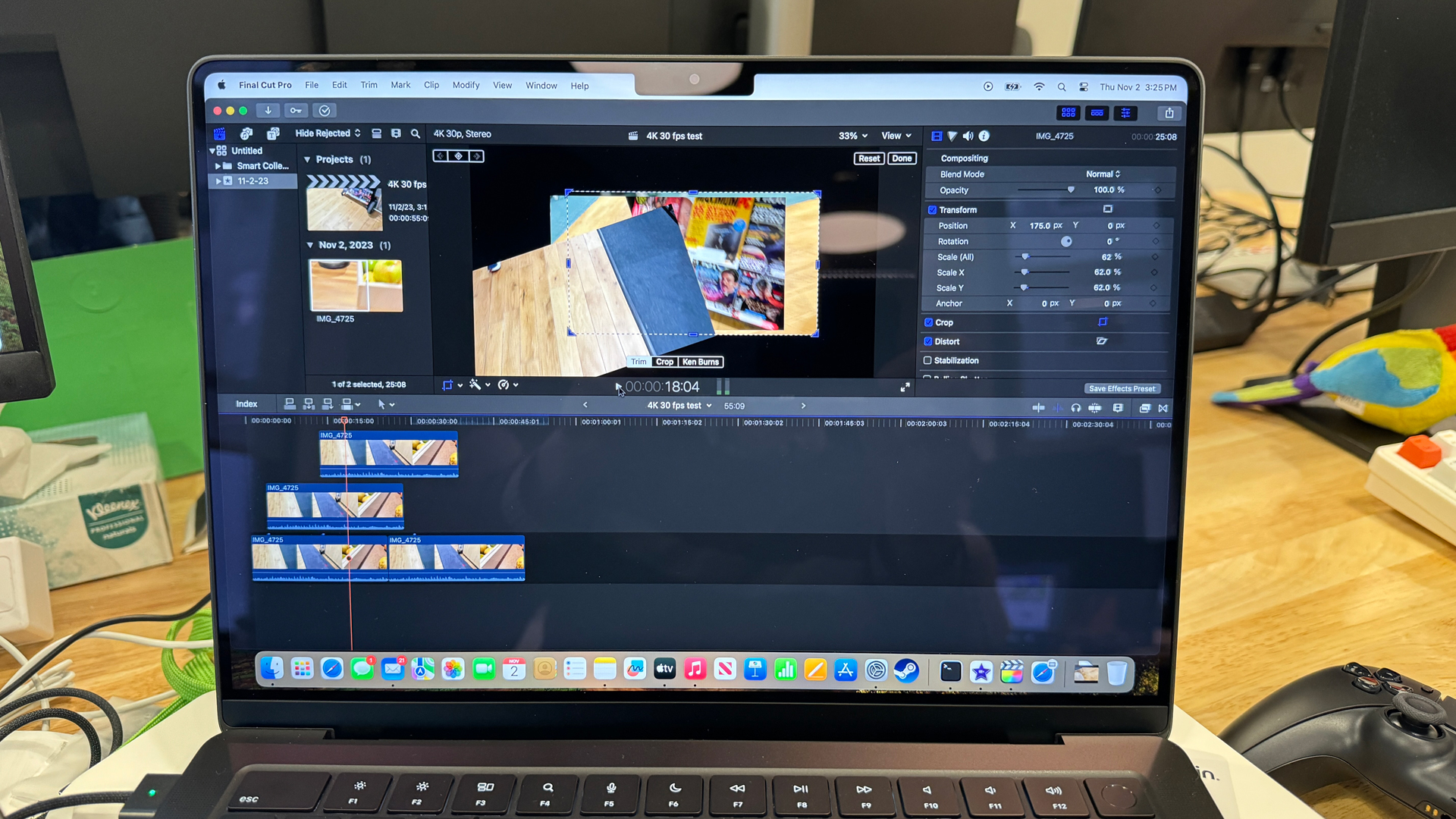
I really like the way Apple makes its chip series more powerful. It uses a standardized architecture, and then wraps more and more cores around it. The benefit is that all systems running the base 3-nanometer process M3 SoC share the same impressive features, but some perform faster than others.
While the bare-bones M3 in the base-model MacBook Pro 14-inch (with one fewer Thunderbolt ports) has an 8-core CPU (four efficiency cores and four performance cores), and a 10-core GPU, the M3 Max chip in the machine I tested has a 16-core CPU and a 40-core GPU. According to Geekbench 6, the system is running a 4.1GHz (single-core) and an estimated 3.3GHz (multi-core).
I ran a lot of benchmarks for raw performance scores, because that's what you do. Unsurprisingly, the GeekBench 6 numbers were startling, and while Apple has taken pains to compare the base M3 to the three-year-old M1 performance, comparing my MacBook Air M2 to the M3 Max was a real eye-opener. Granted, the M3 Max and the base M2 are not really directly comparable, but I think these figures do give you a sense of why you might pay so much for an M3 Max system stuffed with, in my case, 64GB of unified memory (you can, by the way, get a more expensive system with up to 128GB of unified memory and 8TB of storage).

It's easy to forget that Apple silicon is running on the ARM-64 platform, and that not all MacOS apps run natively on it. The reason I often forget this? Everything works. There's never been a moment in my three years of experience with Apple silicon where the MacBook throws up its digital hands and says, "Sorry, I can't run this app." Part of this is down to the rapid adoption of Apple silicon by Apple partners, and also because the Rosetta 2 system (which can translate between x86 code and Apple silicon) runs quietly in the background, managing all apps that are still looking for an x86 platform.
Okay, the MacBook Pro 14 M3 Max is not perfect on the compatibility front. The x86-compatible Steam, which I used for most of my games, did crash. But weirdly, so did iMovie, repeatedly, and that's an ARM native, and later the ARM-friendly Adobe Photoshop 2024. At least the system as a whole never crashes, and doesn't even know the meaning of a blue screen.
Since we're mostly not thinking about compatibility, we can just focus on performance, and the M3 Max is stunning. To be clear, I'm not a professional video editor or doctor analyzing 3D MRI scans, but I did my best to press this system and found it shrugged off all tasks. I opened 40 or so browser tabs on both Safari and Chrome (normally a soul-crushing task for any system), launched Apple TV+, installed Steam, and then played Tomb Raider Legacy. I might as well have been composing something in Notes (oh, wait, I was doing that, too). I loaded up FinalCut Pro with 4K 30fps video as well as some 4K 24fps ProRes HDR content, and edited and manipulated them with ease.
While not visually evident, I think it's also safe to assume that some of the system's speed and ease with all these apps – often running concurrently – is the new Dynamic Caching technology. This is essentially a more efficient way of using available memory. Instead of X number of registers always being used for the same task, the system only applies the memory needed for each, explicit task. The result is a lot less wasted memory and more left over for managing other critical tasks.
Apple spent considerable time during its Scary Fast event telling us how it engineered the new M3 SoC with features specifically designed to handle graphics-intensive tasks like, obviously, AAA games. Hardware-based ray tracing and mesh shading might improve how some of your most expensive apps look, but we all know that it's really all about gaming.
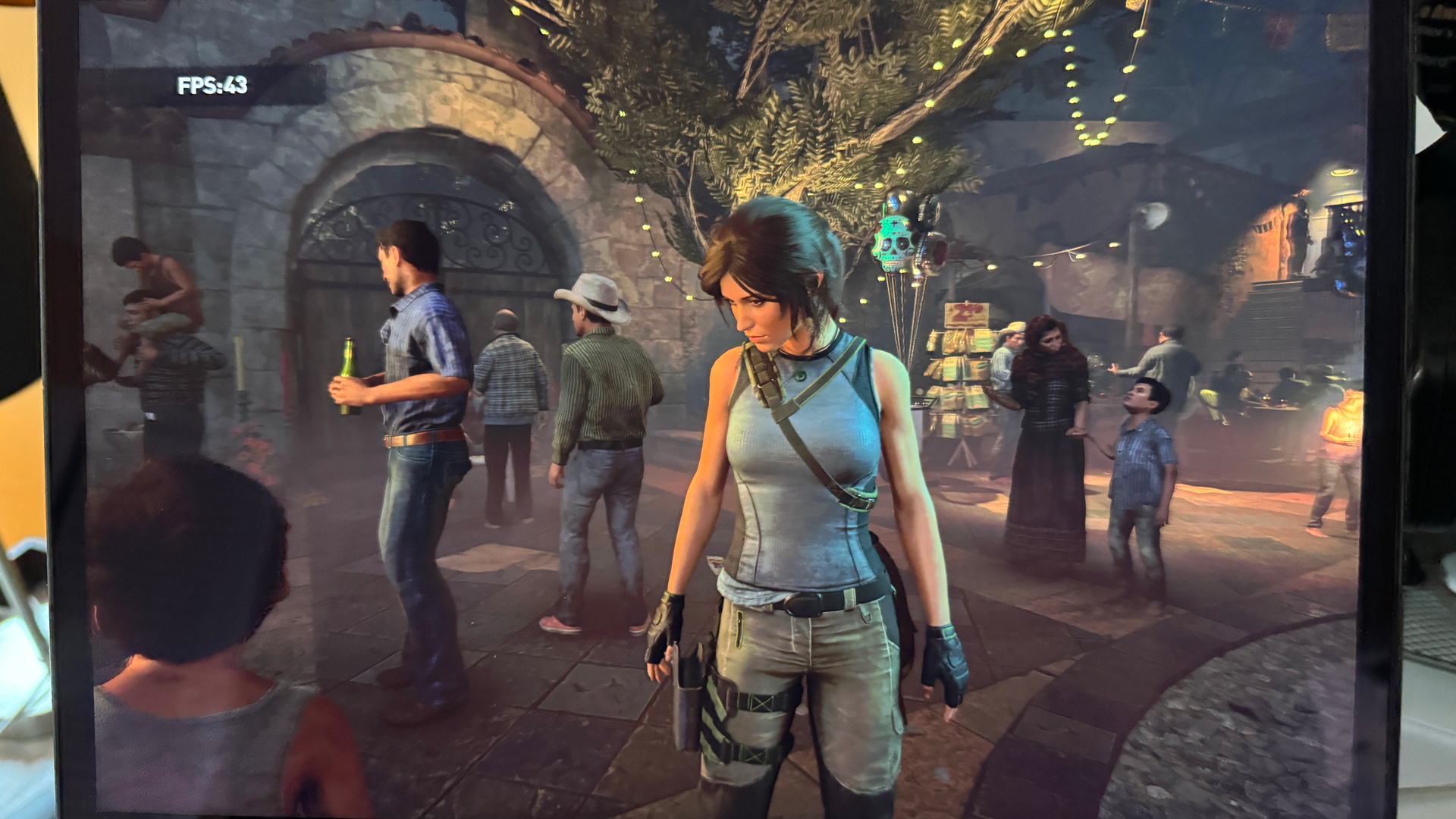


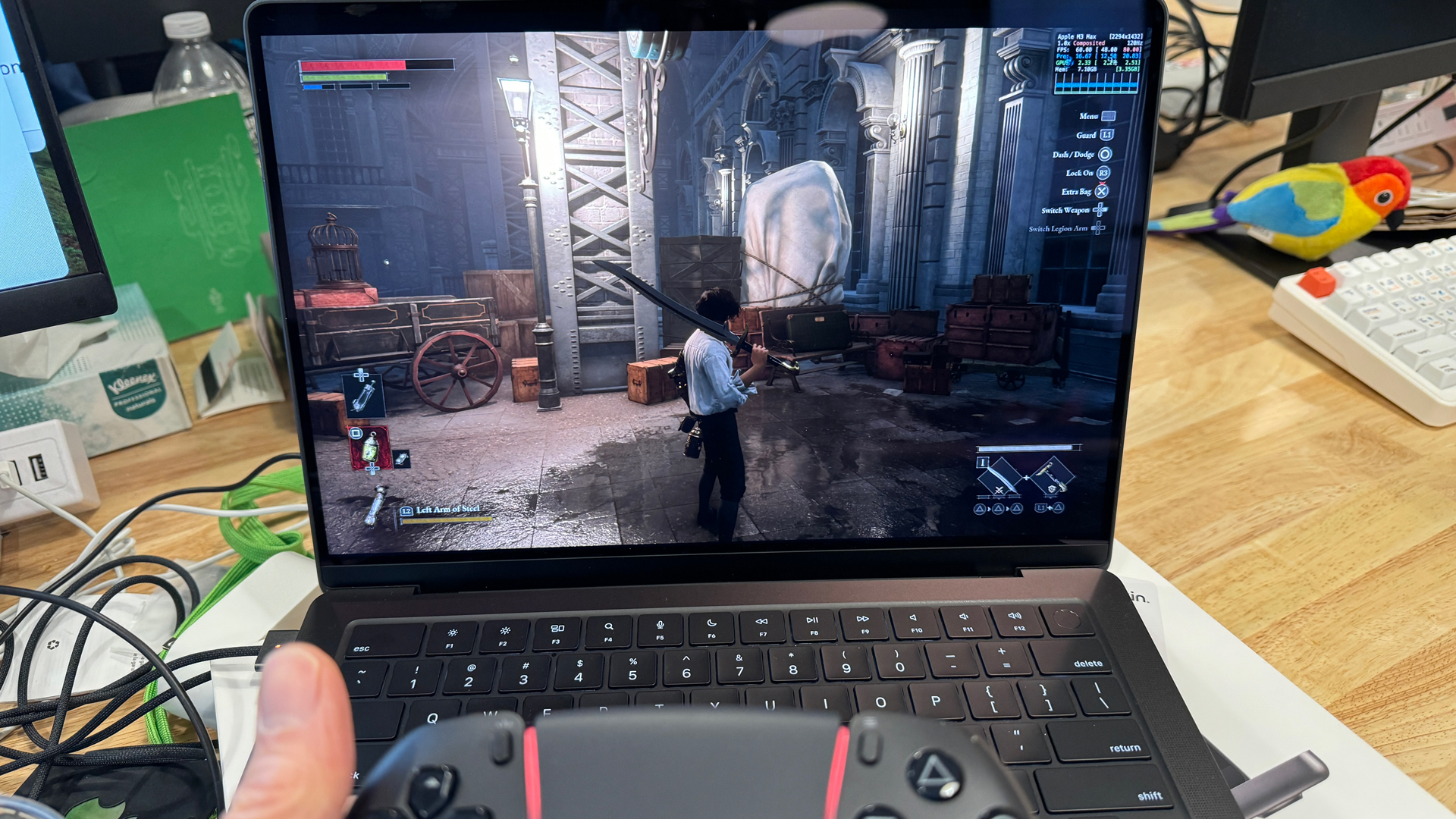

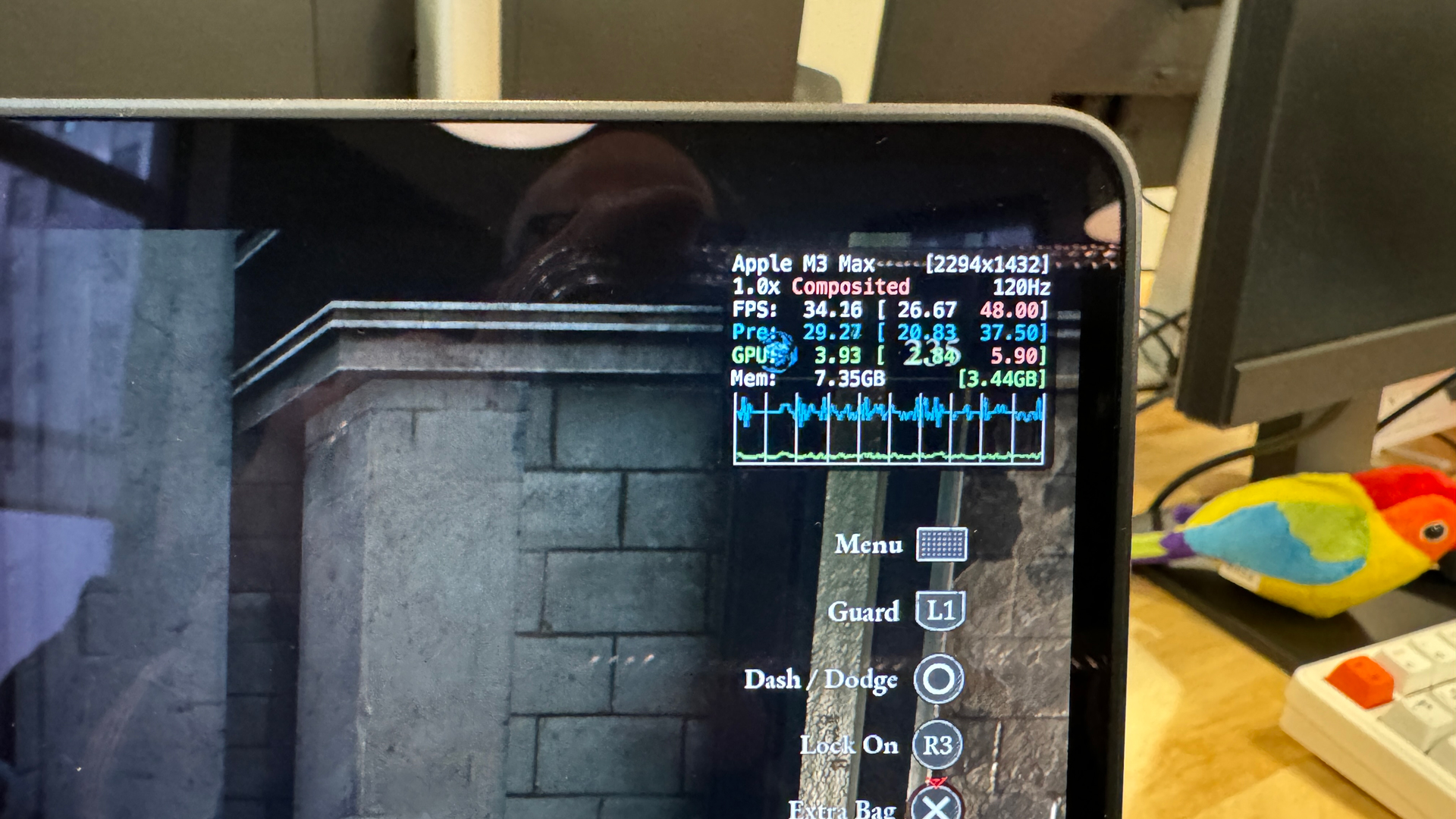
Naturally, I played some games. First, a few hours of the engaging Rise of Tomb Raider, which I will note is not that easy when you're using the keyboard. The eight-year-old game looked good, and gameplay was smooth and immersive. I usually wore my AirPods Pro (they connected instantly) so as to not annoy people around me.
Next, I installed Lies of P, a brand-new game seemingly inspired by Pinocchio, that is at home on all major consoles and now, thanks to Steam, the MacBook Pro, too.
It's a beautiful and quietly atmospheric game that starts in an old, deserted train station. Everything is rendered in such exquisite detail and, thanks to all the M3 Max's onboard graphics power, every surface looked about as real as they can in a game of this nature.
The system seemed to keep up with the action quite well (I played this game with a Bluetooth-connected PlayStation 5 controller; the system supports Bluetooth 5.3, which has just 100ms of latency). I used Terminal for a real-time view of Frame rates and found that, depending on the action, they bounced between 30 and 60fps. Action generally looked smooth in most sequences, including fast-paced puppet-on-puppet battles.
l also played Shadow of the Tomb Raider at the highest possible resolution of 3024 x 1964, and with every atmospheric element turned to the absolute highest. At times, the fans were so loud that they drowned out the game sounds, but the gameplay and graphics were all at their cinematic best, and in the game's benchmarks I could achieve 108fps at 1920 x 1200 mode and 56fps at the highest, native resolution settings. Pretty impressive.
When I cranked all of Total WarHammer III settings to, where possible, ultra, (with 1920 x 1220 resolution), the fan churned on high, and there was some object (or sprite) flickering in the benchmark test. But the detail was all there, and the system reported an average frame rate of 56.1. Then I reran the test at the MacBook Pro's highest native resolution. The gameplay looked even better, naturally, though, the fps dropped to 33.8.
I won't claim to be a hardcore gamer, but it's clear to me that game developers are now thinking about the Mac as a viable platform, using the Game Porting Toolkit Apple released at WWDC 2023 to bring AAA games to the platform on the same date they arrive on your best console. It's not just that the games arrive on the Mac; it's that they're as playable and as immersive as anything on a Windows 11 gaming rig.
Overall, a quick look at all the benchmarks comparing the M1 Max to this M3 Max system shows a quantum leap across every aspect of performance. And, yes, the single number that is lower, AI Turn Time in Civilization VI, is also an improvement, as it shows the system taking less time than before to make that turn.
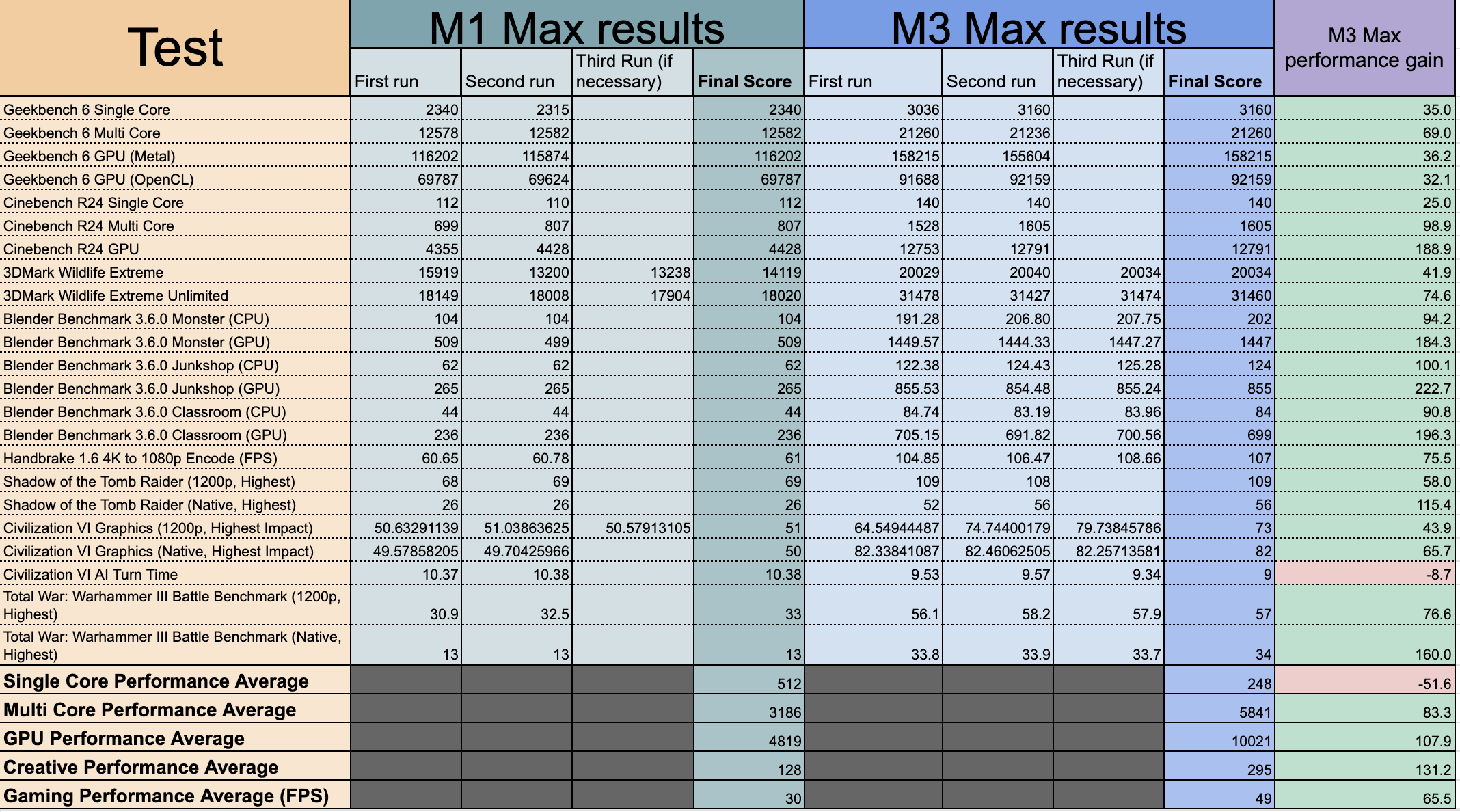
- Performance score: 5/5
MacBook Pro 14-inch (M3 Max, 2023) review: Audio and video
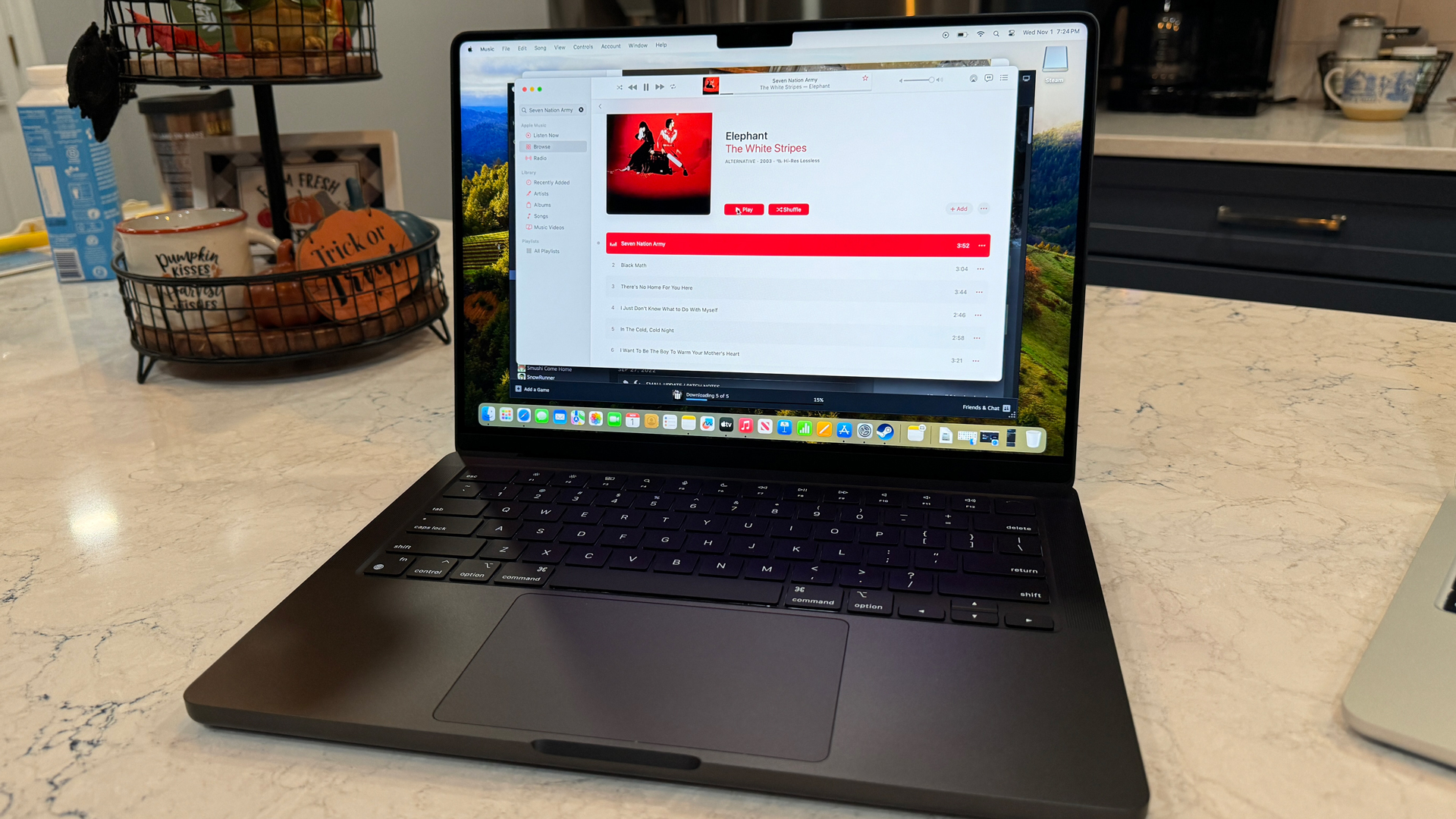
Thanks to the larger system chassis, Apple fits three speakers on either side of the keyboard that can produce loud, clear sound. I played a wide variety of music, video, and gaming content through them. It all sounded great, with voices sharp and high notes clear as a bell. What this sound system lacks, though, is any discernable bass. Now, I wouldn't really expect the MacBook Pro 14 M3 Max's relatively tiny speakers to provide chest-thumping sound. Still, when I played White Stripes Seven Nation Army and Eminem's Lose Yourself I was struck by how flat some of the drums and backbeats sounded. It's not completely devoid of the richness necessary to deliver a nice drum solo, but I found the base side a bit hollow, robbing the tunes of their head-banging essence.
Remarkably, the MacBook Pro 14 still ships with a 3.5mm headphone jack. I'm sure audio and video professionals use it in their work, but for most people, the support you'll find for your best AirPods Pros (especially the head-tracking spatial audio) will be more than enough in-ear audio support.
The MacBook Pro 14 M3 Max comes equipped with the same 1080 FaceTime camera as its predecessor. I can tell you that it gives your callers a nice clear view of you and, thanks to the new native Sonoma webcam features, I can use gestures to set off fireworks, drop confetti, pop up thumbs-up emojis, and release balloons during any video call. My wife wasn't as amused as I thought she'd be.
MacBook Pro 14-inch (M3 Max, 2023) review: Battery life
- Rated for 18 hours
- Lasted in our tests over 12 hours with varied use
- Charges quickly
You may have read some reports that the new MacBook Pro can manage up to 22 hours of battery life. That's the promise for the 14-inch M3 model; however, for my more powerful and more power-hungry M3 Max 14-inch MacBook Pro, the maximum I can expect is 18 hours, and that's only if I do nothing but, say, stream virtually all episodes of Ted Lasso. The number drops down to 12 hours if I'm browsing the web over Wi-Fi. And, in my experience, the duration truly plummets if you play a AAA game like Lies of P or even Tomb Raider Legacy on battery power.
When I started playing the latter game I had about 73% battery life left. Within a couple of hours, it was below 20%. It's clear that the MacBook Pro 14 M3 Max will give you all the gaming power you want and need (I usually played in High Power mode), but there's probably also an assumption that you're playing while plugged in.
My average battery life has been roughly 12 hours of mixed use, which is a little bit less than I was expecting from this more efficient 3-nanometer SoC.
I do have some good news. Fast charging works as promised, and I topped off to 50% in 30 minutes using the included 96W charge adapter and the woven black USB-C-to-MagSafe cable that strikes a discordant note when plugged into the perfectly white adapter (I'm not sure why Apple didn't make that Space Black too).
- Battery life score: 4/5
Should you buy the MacBook Pro 14-inch (M3 Max, 2023)?
Buy it if…
Don’t buy it if…
First reviewed November 2023
Also consider...
If our Apple MacBook Pro 14-inch M3 Max (2023) review has you considering other options, here are three more laptops to consider...
Testing scorecard
How we test
I've spent decades reviewing Apple products, including many of its laptops and desktop systems (I've used Macs on and off since 1985).
For this review, I spent many hours with Apple's newest MacBook Pro and what it says is the most powerful silicon it has ever produced. I did my best to run it through a variety of tasks and played multiple games on it. I also ran a battery of benchmark tests to assess raw performance. We pride ourselves on our independence and our rigorous review-testing process, offering up long-term attention to the products we review and making sure our reviews are updated and maintained, regardless of when a device was released, if you can still buy it, it's on our radar.







